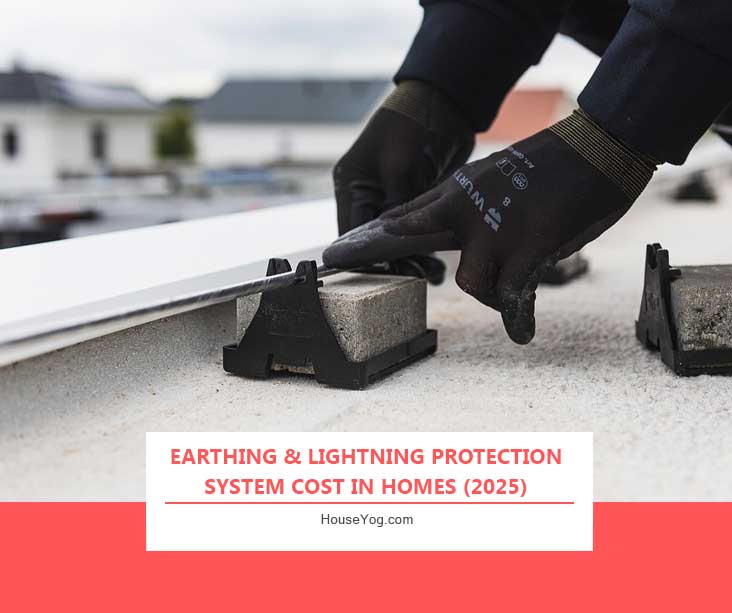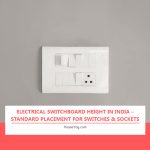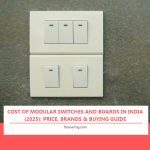Every home that runs on electricity — regardless of its size — requires proper earthing. It’s what keeps your electrical system safe by diverting excess current into the ground during faults or when lightning strikes. Without it, even a small leakage current can cause serious electric shocks or damage expensive appliances.
If you’re constructing a new house or renovating, understanding the earthing system cost, types, and setup requirements can help you plan everything minutely. Today, in this guide, we are sharing everything you need to know about the home earthing system. This guide will help you estimate the earthing cost for a home in India, choose the best earthing system, and budget for materials and labour wisely.
So, are you ready?
Let’s dive deeper.
Earthing System Cost in India (2025)
Wondering how much an earthing system costs in India in 2025? On average, the earthing system cost for homes ranges between ₹3,000 and ₹10,000 per pit — depending on the materials used, type of earthing, soil condition, and labour. Here’s a detailed cost comparison of different earthing types commonly used in Indian houses.
| Type of Earthing | Average Cost (₹/Pit) | Best For |
| Conventional GI Pipe Earthing | ₹3,000–₹4,500 | Small homes, low soil resistance areas |
| Copper Plate Earthing | ₹6,000–₹9,000 | Villas, medium to large homes |
| Chemical (Maintenance-Free) Earthing | ₹7,000–₹10,000 | Modern homes, long-term reliability |
| Lightning Protection System (with Earthing) | ₹15,000–₹25,000 | Large homes, multi-storey buildings |
Note: Costs vary by brand, soil condition, and local labour rates. High-resistance soil (rocky or sandy) may need deeper pits or chemical rods, increasing costs.
Factors Affecting Earthing System Cost
Several factors influence the earthing cost for a home in India — from the type of material used to soil conditions and installation depth. Knowing these factors helps you plan your budget accurately and choose the right system for your property.
- Type of Earthing Material – Copper components are expensive but offer excellent conductivity and long life. GI (Galvanized Iron) is cheaper but prone to corrosion over time.
- Soil Resistivity – Moist, loamy soil provides better conductivity, reducing material depth and cost. Dry or rocky soil increases resistance and requires deeper pits or multiple rods.
- Number of Earthing Pits – A typical 2BHK or 3BHK home needs at least two earthing pits — one for electrical safety and another for the lightning protection or backup system.
- Installation Depth – The deeper the pit (usually 2.5 to 3 meters), the more labour and material are required, increasing the overall cost.
- Brand and Quality of Material – Popular brands like JMV, ABB, Ashlok, or Axis offer maintenance-free earthing systems with longer life expectancy — ideal for modern homes and apartments.
Related: If you’re budgeting for your home’s electrical setup, don’t miss our detailed guide on Electrical Wiring Cost per sq ft in India. It explains wiring rates, material costs, and safety considerations for new homes.
Types of Earthing Systems for Homes
There are several types of earthing systems used in Indian homes, and each offers different levels of safety, cost, and maintenance needs. Here’s a quick breakdown of the most common earthing systems — from economical GI pipe earthing to modern chemical earthing — so you can select the best one for your home:
1. GI Pipe Earthing (Conventional)
This is the most common and economical option used in Indian homes. A GI (galvanised iron) pipe, typically 38–50 mm in diameter, is inserted into the ground vertically and surrounded by charcoal and salt to improve conductivity.
- Cost: ₹3,000–₹4,500 per pit
- Lifespan: 3–5 years (requires periodic maintenance)
- Pros: Affordable, simple to install
- Cons: Corrodes over time; needs regular watering and maintenance
Best for: Small houses in areas with low soil resistance.
2. Copper Plate Earthing
In this method, a copper plate (usually 600mm x 600mm x 3mm) is buried in the earth and connected to the electrical system using copper strips or wires. It provides excellent conductivity and durability.
- Cost: ₹6,000–₹9,000 per pit
- Lifespan: 8–10 years
- Pros: High conductivity, low maintenance
- Cons: Higher cost, risk of theft of copper parts
Best for: Mid-range to premium homes, villas, and bungalows.
3. Chemical (Maintenance-Free) Earthing
The most advanced and long-lasting option — chemical or maintenance-free earthing uses a copper-bonded or GI electrode filled with a conductive gel or backfill compound that maintains low resistance without the need for water or salt.
- Cost: ₹7,000–₹10,000 per pit
- Lifespan: 15–20 years
- Pros: Maintenance-free, consistent resistance, eco-friendly
- Cons: Higher initial cost
Best for: Urban homes, apartments, and smart houses where long-term reliability is crucial.
4. Lightning Protection System
For multi-storey homes or areas prone to storms, lightning arresters combined with earthing systems are essential. The lightning rod on the terrace captures lightning and safely discharges it to the earth through a dedicated earthing path.
- Cost: ₹15,000–₹25,000 (includes arrester, conductors, and earthing pits)
- Pros: Protects entire home from lightning damage
- Cons: Costly installation, requires professional setup
Best for: Large independent houses, farmhouses, and buildings over two storeys.
Also Read: Planning to install rooftop solar panels? Check out our complete guide on Solar Panel Price & Installation Cost in India. It covers setup costs, savings, and system options for Indian homes.
Example: Earthing Cost Estimate for a Typical Home
To help you estimate your total earthing cost for a home, here’s a real-world example showing how much a 2BHK, 3BHK, or villa might spend depending on the system type and number of earthing pits:
| Home Type | Earthing Type | No. of Pits | Approx. Total Cost |
| 2BHK (1000 sq ft) | GI Pipe | 2 | ₹7,000–₹9,000 |
| 3BHK (1500 sq ft) | Copper Plate | 2 | ₹12,000–₹15,000 |
| 4BHK or Villa | Chemical | 2–3 | ₹15,000–₹25,000 |
| Duplex/Bungalow (with Lightning Protection) | Chemical + Lightning | 3+ | ₹25,000–₹40,000 |
Note: Costs include materials, labour, and testing charges but exclude wiring and main MCB panels.
Maintenance Tips for Long-Lasting Earthing
Installing earthing is only half the job — maintaining it properly ensures consistent performance and safety. Follow these key earthing maintenance tips to keep your home’s system efficient for years:
- Regular Testing: Check earth resistance once every 6–12 months using an earth tester.
- Keep Moisture Level: For GI earthing, add water or salt mixture periodically.
- Replace Rusted Components: Change corroded clamps or joints early.
- Avoid Mixing Systems: Stick to the same material (GI or copper) for all components to prevent galvanic corrosion.
Frequently Asked Questions
Here are some of the most commonly asked questions about earthing cost and systems in India to help homeowners make informed decisions.
For long-term use, chemical (maintenance-free) earthing is the best. It’s stable, corrosion-resistant, and doesn’t require water or salt maintenance.
A typical 2BHK–3BHK home needs two pits — one for electrical safety and one for lightning or backup.
Once every 6–12 months to ensure resistance levels are within 1 ohm (for residential setups).
Earthing protects appliances and people from electric shock, while lightning protection safeguards the building structure from lightning strikes. Both work together for total safety.
You may also like: Explore our detailed guide on Rainwater Harvesting Cost in India — learn how much it costs to build an eco-friendly rainwater harvesting setup for your home.
Final Takeaway
In summary, a proper earthing and lightning protection system is essential for every Indian home — not just for safeguarding your appliances, but also for protecting lives. Spending a little extra upfront can prevent costly appliance damage, electrical faults, or even fire hazards later.
In 2025, the earthing system cost in India typically ranges between ₹3,000 and 10,000 per pit, depending on the earthing type, materials used, and soil condition. For long-term reliability and safety, investing in a chemical or copper earthing system is a smart choice.At Houseyog, we help homeowners plan every stage of construction — from architectural design and cost estimation to finishing and fittings. Use our free Construction Cost Calculator to get accurate estimates, or connect with our experts for custom architectural and electrical design assistance for your project.






